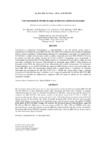Use este identificador para citar ou linkar para este item:
http://www.alice.cnptia.embrapa.br/alice/handle/doc/1014037Registro completo de metadados
| Campo DC | Valor | Idioma |
|---|---|---|
| dc.contributor.author | MACHADO, F. S. | pt_BR |
| dc.contributor.author | RODRIGUEZ, N. M. | pt_BR |
| dc.contributor.author | GONÇALVES, L. C. | pt_BR |
| dc.contributor.author | RODRIGUES, J. A. S. | pt_BR |
| dc.contributor.author | RIBAS, M. N. | pt_BR |
| dc.contributor.author | LOBATO, F. C. L. | pt_BR |
| dc.contributor.author | VEIGA, I. R. F. M. | pt_BR |
| dc.contributor.author | GUIMARAES JUNIOR, R. | pt_BR |
| dc.contributor.author | PEREIRA, L. G. R. | pt_BR |
| dc.date.accessioned | 2015-04-23T11:11:11Z | pt_BR |
| dc.date.available | 2015-04-23T11:11:11Z | pt_BR |
| dc.date.created | 2015-04-23 | pt_BR |
| dc.date.issued | 2014 | pt_BR |
| dc.identifier.citation | Arquivo Brasileiro de Medicina Veterinária e Zootecnia v. 66, n. 1, p. 244-252, 2014. | pt_BR |
| dc.identifier.uri | http://www.alice.cnptia.embrapa.br/alice/handle/doc/1014037 | pt_BR |
| dc.description | RESUMO - Avaliaram-se a composição bromatológica e a digestibilidade in vitro das plantas, folhas, colmos e panículas de três híbridos de sorgo (BRS 610, BR 700 e BRS 655) colhidos em três estádios de maturação (leitoso, pastoso e farináceo). O delineamento utilizado foi o inteiramente casualizado, em arranjo fatorial 3x3 (híbridos x estádios de maturação), sendo as médias comparadas pelo teste SNK (P<0,05). Os teores de matéria seca (MS) das plantas variaram de 25,73% a 43,96% e aumentaram com a maturidade. A concentração de proteína bruta (PB) das plantas manteve-se inalterada (P>0,05) entre as idades de corte para todos os híbridos. Os teores de fibra insolúvel em detergente neutro (FDN) e fibra insolúvel em detergente ácido (FDA) das plantas não foram influenciados pelo estádio de maturação. Os coeficientes de digestibilidade in vitro da MS (DIVMS) das plantas do BRS 610 não variaram com a maturidade, mas para o BR 700 e BRS 655 apresentaram redução entre o estádio leitoso e o farináceo. As variações observadas nas porcentagens de MS, PB, FDN, FDA e DIVMS das frações folha, colmo e panícula ocorreram de forma diferente entre os híbridos com o avanço da maturidade. Os híbridos BR 700 e BRS 655 devem ser ensilados no estádio leitoso, enquanto o BRS 610 pode ser colhido nos três estádios de maturação avaliados. ABSTRACT - The nutritional value of the plants, leaves, stems and panicles of three hybrids of sorghum (BRS 610, BR 700 and BRS 655) at three maturation stages (milk, soft dough and flour) were evaluated. A complete randomized design was used in a factorial arrangement 3x3 (hybrids x ages of cut), and the means were compared by SNK (P<0.05). Dry matter contents of the plants varied from 25.73% to 43.96% and increased with maturity. The percentage of crude protein (CP) of the plants remained constant (P>0.05) among cuts for all the hybrids. The values of neutral detergent fiber (NDF) and acid detergent fiber (ADF) of the plants were not affected by maturation stages. The in vitro dry matter digestibility (IVDMD) of the plants of BRS 610 didn't change with maturity, but decreased between milk and floury stages for BR 700 and BRS 655. Differences in the percentages of DM, CP, NDF, ADF and IVDMD of the plant fractions (leaves, steam and panicle) occurred differently among hybrids with the advance of maturity. The hybrids BR 700 and BRS 655 should be ensiled at milk stage, while the BRS 610 can be harvested at the three maturation stages evaluated. | pt_BR |
| dc.language.iso | por | pt_BR |
| dc.rights | openAccess | pt_BR |
| dc.title | Valor nutricional de híbridos de sorgo em diferentes estádios de maturação. | pt_BR |
| dc.type | Artigo de periódico | pt_BR |
| dc.date.updated | 2015-04-23T11:11:11Z | pt_BR |
| dc.subject.thesagro | Digestibilidade In Vitro | pt_BR |
| dc.subject.thesagro | Sorgo | pt_BR |
| dc.subject.thesagro | Sorghum Bicolor | pt_BR |
| riaa.ainfo.id | 1014037 | pt_BR |
| riaa.ainfo.lastupdate | 2015-04-23 | pt_BR |
| dc.identifier.doi | https://doi.org/10.1590/S0102-09352014000100033 | pt_BR |
| dc.contributor.institution | FERNANDA SAMARINI MACHADO, CNPGL; UFMG; UFMG; UFMG; UFMG; UFMG; LUIZ GUSTAVO RIBEIRO PEREIRA, CNPGL. | pt_BR |
| Aparece nas coleções: | Artigo em periódico indexado (CNPGL)  | |
Arquivos associados a este item:
| Arquivo | Descrição | Tamanho | Formato | |
|---|---|---|---|---|
| Cnpgl2014ArqBrasMedVetZValornutricional.pdf | 253,74 kB | Adobe PDF |  Visualizar/Abrir |









